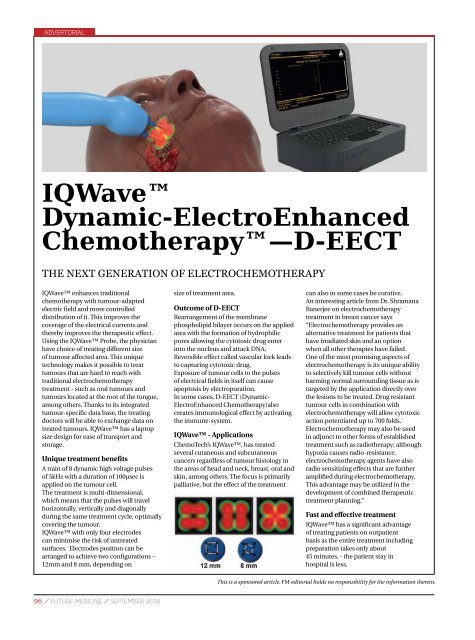FM SEPTEMBER 2018 ISSUE - digital edition
You also want an ePaper? Increase the reach of your titles
YUMPU automatically turns print PDFs into web optimized ePapers that Google loves.
ADVERTORIAL<br />
IQWave<br />
Dynamic-ElectroEnhanced<br />
Chemotherapy —D-EECT<br />
THE NEXT GENERATION OF ELECTROCHEMOTHERAPY<br />
IQWave enhances traditional<br />
chemotherapy with tumour-adapted<br />
electric field and more controlled<br />
distribution of it. This improves the<br />
coverage of the electrical currents and<br />
thereby improves the therapeutic effect.<br />
Using the IQWave Probe, the physician<br />
have choice of treating different size<br />
of tumour affected area. This unique<br />
technology makes it possible to treat<br />
tumours that are hard to reach with<br />
traditional electrochemotherapy<br />
treatment - such as oral tumours and<br />
tumours located at the root of the tongue,<br />
among others. Thanks to its integrated<br />
tumour-specific data base, the treating<br />
doctors will be able to exchange data on<br />
treated tumours. IQWave has a laptop<br />
size design for ease of transport and<br />
storage.<br />
Unique treatment benefits<br />
A train of 8 dynamic high voltage pulses<br />
of 5kHz with a duration of 100µsec is<br />
applied on the tumour cell.<br />
The treatment is multi-dimensional,<br />
which means that the pulses will travel<br />
horizontally, vertically and diagonally<br />
during the same treatment cycle, optimally<br />
covering the tumour.<br />
IQWave with only four electrodes<br />
can minimise the risk of untreated<br />
surfaces. Electrodes position can be<br />
arranged to achieve two configurations –<br />
12mm and 8 mm, depending on<br />
size of treatment area.<br />
Outcome of D-EECT<br />
Rearrangement of the membrane<br />
phospholipid bilayer occurs on the applied<br />
area with the formation of hydrophilic<br />
pores allowing the cytotoxic drug enter<br />
into the nucleus and attack DNA.<br />
Reversible effect called vascular lock leads<br />
to capturing cytotoxic drug.<br />
Exposure of tumour cells to the pulses<br />
of electrical fields in itself can cause<br />
apoptosis by electroporation.<br />
In some cases, D-EECT (Dynamic-<br />
ElectroEnhanced Chemotherapy)also<br />
creates immunological effect by activating<br />
the immune-system.<br />
IQWave - Applications<br />
ChemoTech’s IQWave, has treated<br />
several cutaneous and subcutaneous<br />
cancers regardless of tumour histology in<br />
the areas of head and neck, breast, oral and<br />
skin, among others. The focus is primarily<br />
palliative, but the effect of the treatment<br />
can also in some cases be curative.<br />
An interesting article from Dr. Shramana<br />
Banerjee on electrochemotherapy<br />
treatment in breast cancer says<br />
“Electrochemotherapy provides an<br />
alternative treatment for patients that<br />
have irradiated skin and an option<br />
when all other therapies have failed.<br />
One of the most promising aspects of<br />
electrochemotherapy is its unique ability<br />
to selectively kill tumour cells without<br />
harming normal surrounding tissue as is<br />
targeted by the application directly over<br />
the lesions to be treated. Drug resistant<br />
tumour cells in combination with<br />
electrochemotherapy will allow cytotoxic<br />
action potentiated up to 700 folds.<br />
Electrochemotherapy may also be used<br />
in adjunct to other forms of established<br />
treatment such as radiotherapy; although<br />
hypoxia causes radio-resistance,<br />
electrochemotherapy agents have also<br />
radio sensitizing effects that are further<br />
amplified during electrochemotherapy.<br />
This advantage may be utilized in the<br />
development of combined therapeutic<br />
treatment planning.”<br />
Fast and effective treatment<br />
IQWave has a significant advantage<br />
of treating patients on outpatient<br />
basis as the entire treatment including<br />
preparation takes only about<br />
45 minutes, - the patient stay in<br />
hospital is less.<br />
This is a sponsored article. <strong>FM</strong> editorial holds no responsibility for the information therein.<br />
96 / FUTURE MEDICINE / <strong>SEPTEMBER</strong> <strong>2018</strong>


















